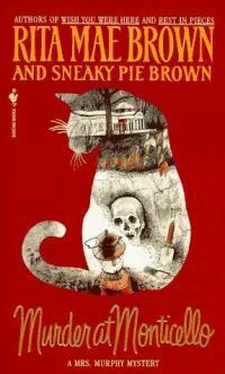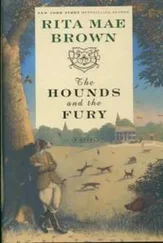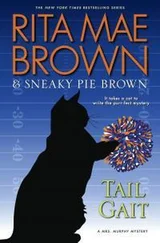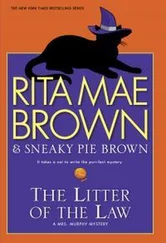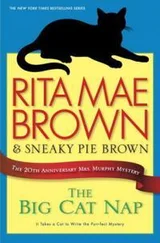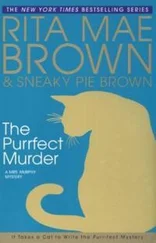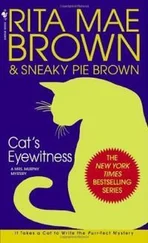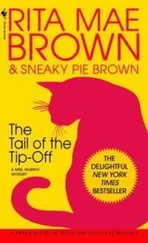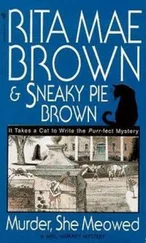MURDER AT
MONTICELLO
Rita Mae Brown
For Gordon Reistrup
because he makes us laugh .

BANTAM BOOKS NEWYORK • TORONTO • LONDON • SYDNEY • AUCKLAND
Cast of Characters
Mary Minor Haristeen (Harry), the young postmistress of Crozet, whose curiosity almost kills the cat and herself
Mrs. Murphy, Harry’s gray tiger cat, who bears an uncanny resemblance to authoress Sneaky Pie and who is wonderfully intelligent!
Tee Tucker, Harry’s Welsh corgi, Mrs. Murphy’s friend and confidant; a buoyant soul
Pharamond Haristeen (Fair), veterinarian, formerly married to Harry
Mrs. George Hogendobber (Miranda), a widow who thumps her own Bible!
Market Shiflett, owner of Shiflett’s Market, next to the post office
Pewter, Market’s fat gray cat, who, when need be, can be pulled away from the food bowl
Susan Tucker, Harry’s best friend, who doesn’t take life too seriously until her neighbors get murdered
Big Marilyn Sanburne (Mim), queen of Crozet
Oliver Zeve, the exuberant director of Monticello, to whom reputation means a lot
Kimball Haynes, energetic young head of archaeology at Monticello. He is a workaholic who believes in digging deeper
Wesley Randolph, owner of Eagle’s Rest, a passionate Thoroughbred man
Warren Randolph, Wesley’s son. He’s trying to step into the old man’s shoes
Ansley Randolph, Warren’s pretty wife, who is smarter than people think
Samson Coles, a well-born realtor who has his eyes on more than property
Lucinda Payne Coles, Samson’s bored wife
Heike Holtz, one of the assistant archaeologists at Monticello
Rick Shaw, Albemarle sheriff
Cynthia Cooper, police officer
Paddy, Mrs. Murphy’s ex-husband, a saucy tom
Simon, an opossum with a low opinion of humanity
Author’s Note
Monticello is a national treasure well served by its current executive director, Daniel P. Jordan. Some of you will recall Mr. Jordan and his wife, Lou, opening Thomas Jefferson’s home to then–President-elect Clinton.
The architectural and landscape descriptions are as accurate as I could make them. The humans are made up, of course, and Oliver Zeve, Monticello’s director in this novel, is not based on Mr. Jordan.
One eerie event took place while I was writing this mystery. In the book, a potsherd of good china is unearthed in a slave cabin. On October 18, 1992, four days after I sent off the first draft of this book to my publisher, an article appeared in The Daily Progress, the newspaper of Charlottesville, Virginia. This article described how William Kelso, Monticello’s director of archaeology, found some fine china in the slave quarters believed to have been inhabited by Sally Hemings. These quarters were close to Jefferson’s home. Often slave quarters were distant from the master’s house, so the location of Miss Heming’s cabin is in itself worthy of note. Finding the china bits was life imitating fiction. Who knows, but it fluffed my fur.
My only quibble with Mr. Jordan and the wonderful staff at Monticello is that they aren’t paying attention to the feline contributions to Mr. Jefferson’s life. Who do you think kept the mice from eating all the parchment that Mr. Jefferson used? Then again, my ancestors drove the moles from the garden and the rodents from the stables too. No doubt when the great man wrote the Declaration of Independence he was inspired by a cat. Who is more independent than a cat?
Human Americans are having a fit and falling in it over multiculturalism. Well, how about multispecies-ism? You think the world centers around humans? When history is taught, Americans really ought to give full attention to the contributions of cats, dogs, horses, cattle, sheep, hens—why, just about any kind of domesticated animal and some of the wild too. Where would our Founding Fathers and Mothers be if they hadn’t had wild turkeys to eat? So abandon that human-centric point of view.
For my part, my feline ancestors arrived on Tidewater shores in 1640. The first Americat was a tabby, one Tabitha Buckingham. I am, therefore, F.F.V.—First Felines of Virginia. Of course, I take pride in my heritage, but I believe any kitty who comes to this country is as much an Americat as I am. We’re all lucky to be here.
As for the human concept of the past, let me just say that history is scandal hallowed by time. Fortunately, human beans (I think of you as beans) being what they are, every nation, every country, produces sufficient scandal. If you all ever behaved reasonably, what would I have to write about?
Always,
SNEAKY PIE
1
Laughing, Mary Minor Haristeen studied the nickel in her upturned palm. Over the likeness of Monticello was inscribed our nation’s motto, E Pluribus Unum. She handed the nickel to her older friend, Mrs. Miranda Hogendobber. “What do you think?”
“That nickel isn’t worth a red cent.” Mrs. Hogendobber pursed her melon-tinted lips. “And the nickel makes Monticello appear so big and impersonal when it’s quite the reverse, if you’ll forgive the pun.”
The two women, one in her mid-thirties and the other at an age she refused to disclose, glanced up from the coin to Monticello’s west portico, its windows aglow with candlelight from the parlor behind as the last rays of the early spring sun dipped behind the Blue Ridge Mountains.
If the friends had strolled to the front door of Thomas Jefferson’s house, centered in the east portico, and then walked to the edge of the lawn, they would have viewed a sea of green, the ever-flattening topography to Richmond and ultimately to the Atlantic Ocean.
Like most born residents of central Virginia’s Albemarle County, Harry Haristeen, as she was known, and Miranda Hogendobber could provide a fascinating tour of Monticello. Miranda would admit to being familiar with the estate since before World War II, but that was all she would admit. Over the decades increasing restoration work on the house itself, the dependencies, and gardens, both food and flowering, had progressed to the point where Monticello was the pride of the entire United States. Over a million out-of-town visitors a year drove up the tricky mountain road to pay their eight dollars, board a jitney bus, and swirl around an even twistier road to the top of the hill and thence the redbrick structure—each brick fashioned by hand, each hinge pounded out in a smithy, each pane of glass painstakingly blown by a glassmaker, sweating and puffing. Everything about the house suggested individual contribution, imagination, simplicity.
As the tulips braved the quickening western winds, Harry and Mrs. Hogendobber, shivering, walked around the south side of the grounds by the raised terrace. A graceful silver maple anchored the corner where they turned. When they reached the front they paused by the large doors.
Читать дальше
